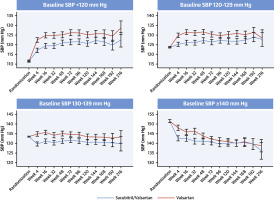当前位置:
X-MOL 学术
›
J. Am. Coll. Cardiol.
›
论文详情
Our official English website, www.x-mol.net, welcomes your
feedback! (Note: you will need to create a separate account there.)
Systolic Blood Pressure in Heart Failure With Preserved Ejection Fraction Treated With Sacubitril/Valsartan
Journal of the American College of Cardiology ( IF 21.7 ) Pub Date : 2020-04-01 , DOI: 10.1016/j.jacc.2020.02.009 Senthil Selvaraj 1 , Brian L Claggett 2 , Michael Böhm 3 , Stefan D Anker 3 , Muthiah Vaduganathan 2 , Faiez Zannad 4 , Burkert Pieske 5 , Carolyn S P Lam 6 , Inder S Anand 7 , Victor C Shi 8 , Martin P Lefkowitz 8 , John J V McMurray 9 , Scott D Solomon 2
Journal of the American College of Cardiology ( IF 21.7 ) Pub Date : 2020-04-01 , DOI: 10.1016/j.jacc.2020.02.009 Senthil Selvaraj 1 , Brian L Claggett 2 , Michael Böhm 3 , Stefan D Anker 3 , Muthiah Vaduganathan 2 , Faiez Zannad 4 , Burkert Pieske 5 , Carolyn S P Lam 6 , Inder S Anand 7 , Victor C Shi 8 , Martin P Lefkowitz 8 , John J V McMurray 9 , Scott D Solomon 2
Affiliation

|
BACKGROUND
Guidelines recommend targeting systolic blood pressure (SBP) <130 mm Hg in heart failure with preserved ejection fraction (HFpEF) with limited data. OBJECTIVES
This study sought to determine the optimal achieved SBP and whether the treatment effects of sacubitril/valsartan on outcomes are related to BP lowering, particularly among women who derive greater benefit from sacubitril/valsartan. METHODS
Using 4,795 trial participants, this study related baseline and time-updated mean achieved SBP quartiles (<120, 120 to 129, 130 to 139, ≥140 mm Hg) to the primary outcome (cardiovascular death and total heart failure hospitalization), its components, myocardial infarction or stroke, and a renal composite outcome. At the 16-week visit, the study assessed the relationship between SBP change and Kansas City Cardiomyopathy Questionnaire overall summary score (KCCQ-OSS) and N-terminal pro-B-type natriuretic peptide (NT-proBNP). The study analyzed whether the BP-lowering effects of sacubitril/valsartan accounted for its treatment effects. RESULTS
Average age was 73 ± 8 years, and 52% of participants were women. After multivariable adjustment, baseline and mean achieved SBP of 120 to 129 mm Hg demonstrated the lowest risk for all outcomes. Sacubitril/valsartan reduced SBP by 5.2 mm Hg (95% confidence interval: 4.4 to 6.0) compared with valsartan at 4 weeks, which was not modified by baseline SBP. However, sacubitril/valsartan reduced SBP more in women (6.3 mm Hg) than men (4.0 mm Hg) (interaction p = 0.005). Change in SBP was directly associated with change in NT-proBNP (p < 0.001) but not KCCQ-OSS (p = 0.40). The association between sacubitril/valsartan and the primary outcome was not modified by baseline SBP (interaction p = 0.50) and was similar when adjusting for time-updated SBP, regardless of sex. CONCLUSIONS
Baseline and mean achieved SBP of 120 to 129 mm Hg identified the lowest risk patients with HFpEF. Baseline SBP did not modify the treatment effect of sacubitril/valsartan, and the BP-lowering effects of sacubitril/valsartan did not account for its effects on outcomes, regardless of sex. (Prospective Comparison of ARNI With ARB Global Outcomes in HF With Preserved Ejection Fraction [PARAGON-HF]; NCT01920711).
中文翻译:

沙库巴曲/缬沙坦治疗保留射血分数的心力衰竭患者的收缩压
背景指南建议射血分数保留的心力衰竭 (HFpEF) 患者的收缩压 (SBP) <130 mm Hg 为目标,但数据有限。目的 本研究旨在确定达到的最佳收缩压以及沙库巴曲/缬沙坦对结局的治疗效果是否与血压降低相关,特别是对于从沙库巴曲/缬沙坦获得更大益处的女性。方法 本研究使用 4,795 名试验参与者,将基线和时间更新的平均收缩压四分位数(<120、120 至 129、130 至 139、≥140 mm Hg)与主要结局(心血管死亡和完全心力衰竭住院治疗)相关联,其成分,心肌梗塞或中风,以及肾脏复合结局。在为期 16 周的访视中,该研究评估了 SBP 变化与堪萨斯城心肌病问卷总体评分 (KCCQ-OSS) 和 N 末端 B 型利钠肽原 (NT-proBNP) 之间的关系。该研究分析了沙库巴曲/缬沙坦的降压作用是否可以解释其治疗效果。结果 平均年龄为 73 ± 8 岁,52% 的参与者为女性。经过多变量调整后,基线和平均收缩压达到 120 至 129 毫米汞柱,证明所有结果的风险最低。 4 周时,与缬沙坦相比,沙库巴曲/缬沙坦使 SBP 降低 5.2 mm Hg(95% 置信区间:4.4 至 6.0),且基线 SBP 未改变这一结果。然而,沙库巴曲/缬沙坦对女性收缩压的降低幅度(6.3 毫米汞柱)多于男性(4.0 毫米汞柱)(交互作用 p = 0.005)。 SBP 的变化与 NT-proBNP 的变化直接相关 (p < 0.001),但与 KCCQ-OSS 无关 (p = 0.40)。沙库巴曲/缬沙坦与主要结局之间的关联并未因基线收缩压而改变(交互作用 p = 0。50),并且在调整时间更新的 SBP 时相似,无论性别如何。结论 基线和平均收缩压达到 120 至 129 mm Hg 即可确定 HFpEF 风险最低的患者。基线收缩压不会改变沙库巴曲/缬沙坦的治疗效果,并且沙库巴曲/缬沙坦的降压作用并不能解释其对结果的影响,无论性别如何。 (ARNI 与 ARB 在保留射血分数的心力衰竭中的全球结果的前瞻性比较 [PARAGON-HF];NCT01920711)。
更新日期:2020-04-01
中文翻译:

沙库巴曲/缬沙坦治疗保留射血分数的心力衰竭患者的收缩压
背景指南建议射血分数保留的心力衰竭 (HFpEF) 患者的收缩压 (SBP) <130 mm Hg 为目标,但数据有限。目的 本研究旨在确定达到的最佳收缩压以及沙库巴曲/缬沙坦对结局的治疗效果是否与血压降低相关,特别是对于从沙库巴曲/缬沙坦获得更大益处的女性。方法 本研究使用 4,795 名试验参与者,将基线和时间更新的平均收缩压四分位数(<120、120 至 129、130 至 139、≥140 mm Hg)与主要结局(心血管死亡和完全心力衰竭住院治疗)相关联,其成分,心肌梗塞或中风,以及肾脏复合结局。在为期 16 周的访视中,该研究评估了 SBP 变化与堪萨斯城心肌病问卷总体评分 (KCCQ-OSS) 和 N 末端 B 型利钠肽原 (NT-proBNP) 之间的关系。该研究分析了沙库巴曲/缬沙坦的降压作用是否可以解释其治疗效果。结果 平均年龄为 73 ± 8 岁,52% 的参与者为女性。经过多变量调整后,基线和平均收缩压达到 120 至 129 毫米汞柱,证明所有结果的风险最低。 4 周时,与缬沙坦相比,沙库巴曲/缬沙坦使 SBP 降低 5.2 mm Hg(95% 置信区间:4.4 至 6.0),且基线 SBP 未改变这一结果。然而,沙库巴曲/缬沙坦对女性收缩压的降低幅度(6.3 毫米汞柱)多于男性(4.0 毫米汞柱)(交互作用 p = 0.005)。 SBP 的变化与 NT-proBNP 的变化直接相关 (p < 0.001),但与 KCCQ-OSS 无关 (p = 0.40)。沙库巴曲/缬沙坦与主要结局之间的关联并未因基线收缩压而改变(交互作用 p = 0。50),并且在调整时间更新的 SBP 时相似,无论性别如何。结论 基线和平均收缩压达到 120 至 129 mm Hg 即可确定 HFpEF 风险最低的患者。基线收缩压不会改变沙库巴曲/缬沙坦的治疗效果,并且沙库巴曲/缬沙坦的降压作用并不能解释其对结果的影响,无论性别如何。 (ARNI 与 ARB 在保留射血分数的心力衰竭中的全球结果的前瞻性比较 [PARAGON-HF];NCT01920711)。











































 京公网安备 11010802027423号
京公网安备 11010802027423号